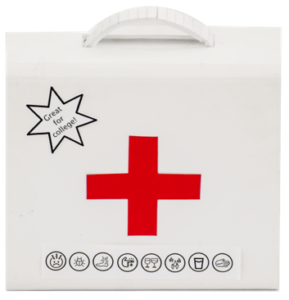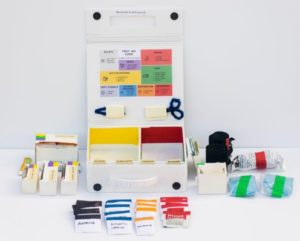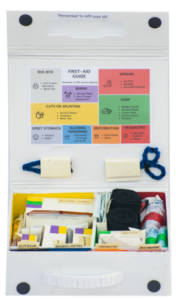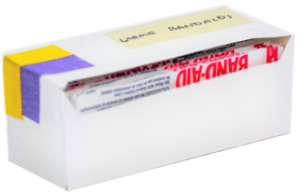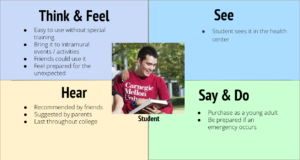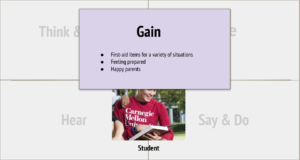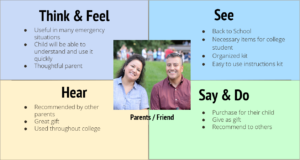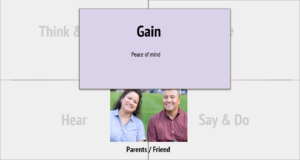Duration: 25 hours
Team Members: 4
Skills Applied: Composition, Foamcore Modeling, Rapid Prototyping, Sketching, User Research
Tools Used: Exacto Knife, Tape
The Easy Aid first aid kit is catered specifically to college students living in a dorm setting. This project was developed in a team of four. This kit needed to still have the necessities of a standard first aid kit that treated things like cuts, burns, large gashes and bug bites. To fit our target user, a college student, we added more specific products tailored to the environment they were in.
We created a First-Aid kit which is:
●Easy to use
●Intuitive
●Informative
●Organized
●Compact
●Identifiable
Ethos
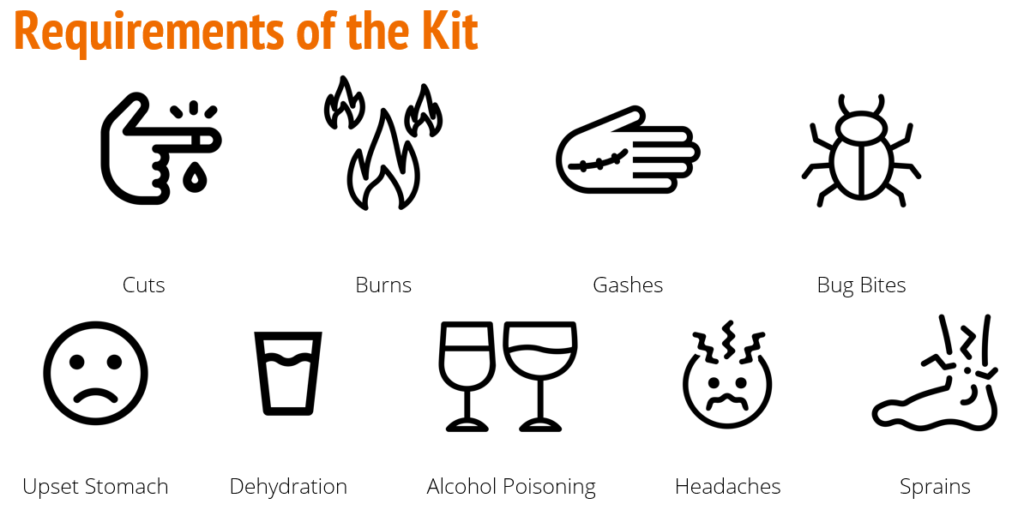
Since the a college student will likely face incidents that are unique to their lifestyles and living situation, we decided the most common and important types of illnesses they or their friends might contract. Most notably, we included items for dehydration and alcohol poisoning.
For our design, we came up with seven principles that were the core ideals behind our choices during the design process.

Principle 1 Equitable Use: same means for all users for USA; no user is segregated or stigmatized; universal appeal for this first aid kit
Principle 2 Flexibility in Use: accommodate left and right hand use; facilitate users precision and accuracy by color coding; adaptable to user’s pace
Principle 3 Simple and Intuitive: Eliminated unnecessary complexity in dispensers, opening the kit; consistent with user’s expectation and intuition; effective feedback and prompting ‘ information consistent with importance
Principle 4 Perceptible Information: use of pictures and graphics; glow in the dark label for easy perception
Principle 5 Tolerance of error: rounded edges (fail safe feature) and easy to reassemble
Principle 6 Low physical effort: easy to open and close the kit; repetitive action of bandages and gauze taken care of; color coding minimize the effort of finding stuff
Principle 7 Size and Space: the same sized kit had been better optimised to improve the organization of the kit
The kit seen here is a prototype. The front of the kit features pictographs depicting possible ailments the kit can treat. We maintained the standard white and red cross scheme to help with immediate identification. There is a sticker that indicates the product is great for college, and the side of the box lists features.
The back of the box features the drug facts for the medications enclosed, as well as an inventory list.
The other siding of the box has a label that gives room for Name, Room Number, and Contact Phone numbers.
The standard practice of opening the kit with 2 hands has been eliminated. We replaced this with a more intuitive design, a magnetic closure that can easily be flipped open. Now, the box can open it just using one hand. It is also equitable for both left-handed and right-handed users. The handle of the box also collapses flat for easy storage.
The kit is easy to assemble and the final product would feature rounded edges to provide an empathetic design. Other changes include, making the entire box a transparent white plastic. The red cross would also glow in the dark, as we expect the users to store this product under their bed or in a closet.
Principles 1, 2, 4, 5, and 6 were applied here.
Organizing the kit was one of the primary importance for us. This calms the user in moments of panic and pain, and streamlines the process of searching for the appropriate items.
On the lid, a reminder to refill the items is displayed. The cover for scissors and tweezers have been included to provide tolerance of error.

The lid also features a color coded guide for the products enclosed based on likely use.
Labels are made using graphics having universal meaning. And color coding makes the information more perceptible to users.
An information label with all the drug facts and contents of the kit has been included on the rear face for equitable use.
Principles 3, 4, 5, 6, and 7 were applied here.
Bandages and gauze are one of the most used element of a first aid kit; therefore eliminating the unnecessary complexity to pull out a bandage was an important feature to make the kit simple and intuitive to use. Now the bandage can be pulled out using just one hand and thus low physical effort is involved. These dispensers are individually color coded to make them more perceptible.
Principles 3, 4, and 6 were applied here.
Marketing
We also developed three user profiles for potential clients.

For the customer profiles, we used an empathy map to try to understand the users.
Sales
Retail Price: $34.99
Estimated Manufacturing Cost: $12.50
Plastics, cardboard boxes, materials, labels/manual
Margin: 35%
Documentation can be seen on the next page.

